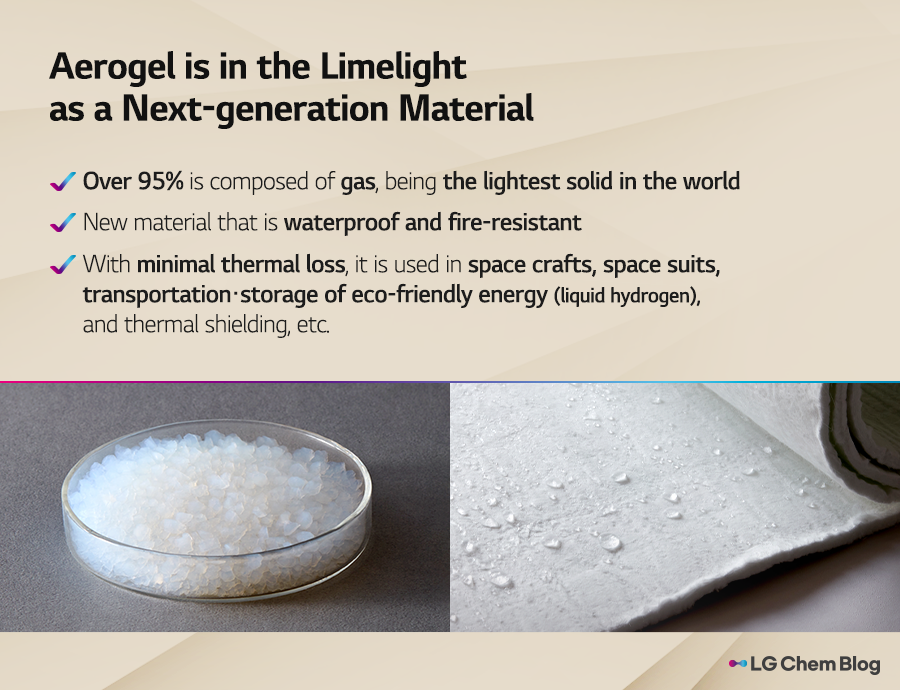Beginning construction of pyrolysis oil and aerogel plant! LG Chem breaks the ground for a sustainable future!
2023. 12. 15
2023. 12. 15
LG Chem is practicing carbon neutrality by leading the development of eco-friendly materials. In 2023, the company continued their actions to cut down carbon, such as producing eco-friendly raw materials and introducing innovative processes. On March 30th 2023, LG Chem held a groundbreaking ceremony of ‘supercritical pyrolysis oil’ and ‘next-generation insulator aerogel’ plants within the Seongmun National Industrial Complex in Dangjin, South Chungcheong Province, Korea, as an effort to establish a plastic circular economy. By doing this, the company aims to develop next-generation materials that utilize recycled resources across their whole process, from raw material to product and distribution. Until 2024, LG Chem plans to invest $238 million (KRW 310 billion) to construct a supercritical pyrolysis oil plant and aerogel plant within the Seongmun National Industrial Complex, which will stretch over 240,000㎡ (the size of 32 soccer fields), as a part of their investment in eco-friendly future business. Let us introduce Dangjin plant, as LG Chem prepares for a sustainable future.
A well-known method of recycling plastic is ‘mechanical recycling,’ which crushes plastic to reform it as a raw material. However, mechanical recycling cannot process all plastics. To compensate this limitation, ‘chemical recycling’ was developed. To put it simply, chemical recycling uses pyrolysis or chemical reactions to break down plastic, and synthesize it to create a new chemical material which is then reused for various purposes. This method is recognized as an eco-friendly way of reducing plastic wastes and heightening the possibility of resource maintenance and regeneration.
After long research, LG Chem overcame the challenges and succeeded in developing the ‘supercritical pyrolysis technology.’ As an example of a chemical recycling method, this is a technology of breaking down waste plastics by utilizing high-temperature/high-pressure supercritical vapor. You can put plastics that are unable to process by mechanical recycling in a high-temperature container, heat them up, and filter out any contaminant from the liquid and gas attained from this process. This yields pyrolysis oil, a raw material that can form brand-new plastics.
Using the supercritical pyrolysis technology enables recycling of composite materials (OTHER), such as snack wrappers, vinyl wrappers for precooked rice, and delivery containers, that had limitations in traditional recycling methods. The pyrolysis oil obtained through this technology does not affect the physical properties of the final product, therefore is applicable to all products. By recycling vinyl and plastic waste using the supercritical pyrolysis technology, we can convert 8 tons out of 10 tons of waste plastics into a recycled raw material, and the byproduct gas released by the remaining 2 tons can also be reused as an energy to operate the plant, such as in producing supercritical vapor. LG Chem’s Dangjin plant in South Chungcheong Province, Korea, is the first domestic supercritical pyrolysis plant to be built, and is expected to be equipped with productivity that will top the industry. Here, LG Chem plans to produce annual 20,000 tons of waste plastic pyrolysis oil.

Aerogel, gaining attention as a next-generation material, is composed of over 95% gas. It is light as air, and hardly absorbs any fine particles or heat. With high heat-resistance and low density, it has been often used as a thermal-resistant material in the aerospace industry. Recently, it is also receiving spotlight as an insulator, as it can minimize thermal loss when used in plumbing or other facilities in industrial sites. Furthermore, it can also be used in the transportation · storage of liquid hydrogen, a type of eco-friendly energy, or thermal shielding in batteries. In short, the demand for aerogel is rising across various industries, including electronics, building materials, and medical fields. Since 2013, LG Chem has been carrying out the research and development of aerogel, and applied for over 100 patents. In 2024, the company has scheduled to construct an aerogel plant in Dangjin, and begin commercialization of the product.

In the global chemical recycling market, the use of pyrolysis oil (extracted from waste plastic only) is expected to rise by annual 19% to reach 3.3 million tons in 2023. Along with it, the demand for aerogel keeps increasing, and prospects are that it will grow by an average of 30% every year. Starting from the groundbreaking of pyrolysis oil and aerogel plants in Dangjin, LG Chem intends to expand their eco-friendly and next-generation business to a larger scale. Please look forward to LG Chem as they take steps towards carbon neutrality!

There are no comments yet! Be the first to let us know your thoughts!